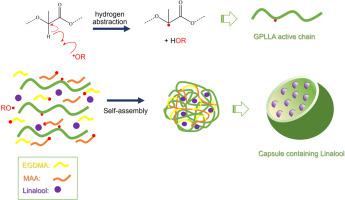Colloids and Surfaces B: Biointerfaces ( IF 5.8 ) Pub Date : 2021-09-21 , DOI: 10.1016/j.colsurfb.2021.112122 Chayanan Khotchana 1 , Pongsathon Phapugrangkul 2 , Pakorn Opaprakasit 3 , Dolnapa Kaewpa 4 , Preeyaporn Chaiyasat 5 , Amorn Chaiyasat 5

|
Poly(l-lactic acid) (PLLA) is a well-known biopolymer, usually synthesized via step-growth or ring-opening polymerization from lactic acid or a lactide monomer, respectively. PLLA microspherical particles are produced by dispersion polymerization with a ring-opening lactide monomer using a particular copolymer chain as a stabilizer. This is not easy to achieve when dehydration is needed. Here, a robust and simple synthesis of a nearly monodisperse, submicron PLLA-based particle/capsule was proposed via radical precipitation polymerization without the use of surfactant. A commercial PLLA was first glycolyzed with ethylene glycol to obtain a low molecular weight glycolyzed PLLA (GPLLA). Then, the GPLLA was copolymerized with methacrylic acid and ethylene glycol dimethacrylate monomers using a benzoyl peroxide initiator. Active sites on the GPLLA backbone were generated by hydrogen abstraction of benzoyloxy radicals that further copolymerized before self-assembly to form the polymer particles. Uniform particle size of about 580 nm with a low polydispersity index (PDI) of 0.012 was obtained. This method was also implemented to produce nearly monodisperse capsules containing linalool. The particle size of PLLA-based capsules was about 280 nm with narrow particle size distribution (PDI of 0.120). The PLLA-based capsules effectively inhibited microbial growth of Staphylococcus aureus, Escherichia coli and Candida albicans and were not toxic to human cells.
中文翻译:

通过自由基沉淀聚合合成均匀亚微米聚(乳酸)基颗粒/胶囊
聚(l-乳酸)(PLLA)是一种众所周知的生物聚合物,通常分别由乳酸或丙交酯单体通过逐步生长或开环聚合合成。PLLA 微球颗粒是通过使用特定的共聚物链作为稳定剂与开环丙交酯单体进行分散聚合而生产的。当需要脱水时,这并不容易实现。在这里,通过自由基沉淀聚合而不使用表面活性剂,提出了一种稳定且简单的近单分散、亚微米 PLLA 基颗粒/胶囊的合成方法。市售的 PLLA 首先用乙二醇进行糖酵解以获得低分子量糖酵解 PLLA (GPLLA)。然后,使用过氧化苯甲酰引发剂将 GPLLA 与甲基丙烯酸和乙二醇二甲基丙烯酸酯单体共聚。GPLLA 主链上的活性位点是通过苯甲酰氧基的夺氢产生的,苯甲酰氧基在自组装形成聚合物颗粒之前进一步共聚。获得了约 580 nm 的均匀粒径和 0.012 的低多分散指数 (PDI)。该方法还用于生产几乎单分散的含有芳樟醇的胶囊。基于 PLLA 的胶囊的粒径约为 280 nm,粒径分布较窄(PDI 为 0.120)。基于 PLLA 的胶囊有效地抑制了微生物的生长 该方法还用于生产几乎单分散的含有芳樟醇的胶囊。基于 PLLA 的胶囊的粒径约为 280 nm,粒径分布较窄(PDI 为 0.120)。基于 PLLA 的胶囊有效地抑制了微生物的生长 该方法还用于生产几乎单分散的含有芳樟醇的胶囊。基于 PLLA 的胶囊的粒径约为 280 nm,粒径分布较窄(PDI 为 0.120)。基于 PLLA 的胶囊有效地抑制了微生物的生长金黄色葡萄球菌、大肠杆菌和白色念珠菌对人体细胞无毒。



























 京公网安备 11010802027423号
京公网安备 11010802027423号